科技英语翻译-第2章分析
- 格式:ppt
- 大小:143.00 KB
- 文档页数:31

科技英语翻译1.1 翻译的标准第1节翻译练习1The power plant is the heart of a ship.The power unit for driving the machines is a 50-hp induction motor.动力装置是船舶的心脏。
驱动这些机器的动力装置是一台50马力的感应电动机。
第1节翻译练习2Semiconductor devices, called transistors, are replacing tubes in many applications.Cramped conditions means that passengers’ legs cannot move around freely.All bodies are known to possess weight and occupy space.半导体装置也称为晶体管,在许多场合替代电子管。
我们知道,所有的物体都有重量并占据空间。
空间狭窄,旅客的两腿就不能自由活动。
第1节翻译练习3The removal of minerals from water is called softening.A typical foliage leaf of a plant belonging to the dicotyledons is composed of two principal parts: blade and petiole.去除水中的矿物质叫做软化。
双子叶植物典型的营养叶由两个主要部分组成:叶片和叶柄。
1.2 对译者的要求第4节翻译练习1Einstein’s relativity theory is the only one which can explain such phenomena. All four (outer planets) probably have cores of metals, silicates, and water. 爱因斯坦的相对论是能解释这种现象的唯一理论。
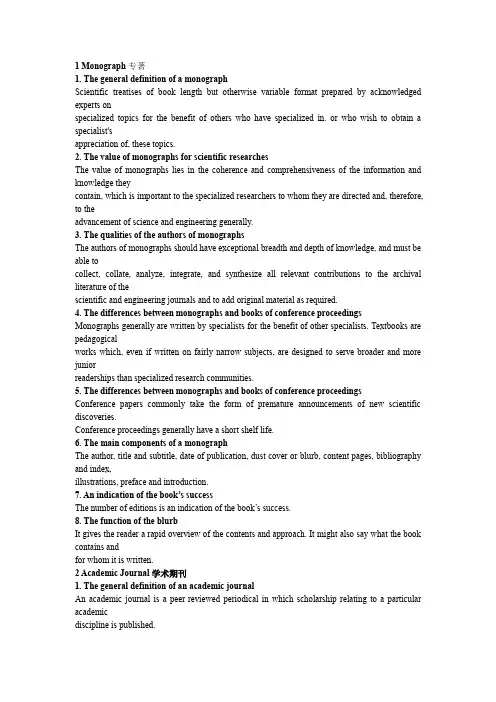
1 Monograph专著1. The general definition of a monographScientific treatises of book length but otherwise variable format prepared by acknowledged experts onspecialized topics for the benefit of others who have specialized in. or who wish to obtain a specialist'sappreciation of, these topics.2. The value of monographs for scientific researchesThe value of monographs lies in the coherence and comprehensiveness of the information and knowledge theycontain, which is important to the specialized researchers to whom they are directed and, therefore, to theadvancement of science and engineering generally.3. The qualities of the authors of monographsThe authors of monographs should have exceptional breadth and depth of knowledge, and must be able tocollect, collate, analyze, integrate, and synthesize all relevant contributions to the archival literature of thescientific and engineering journals and to add original material as required.4. The differences between monographs and books of conference proceedingsMonographs generally are written by specialists for the benefit of other specialists. Textbooks are pedagogicalworks which, even if written on fairly narrow subjects, are designed to serve broader and more juniorreaderships than specialized research communities.5. The differences between monographs and books of conference proceedingsConference papers commonly take the form of premature announcements of new scientific discoveries.Conference proceedings generally have a short shelf life.6. The main components of a monographThe author, title and subtitle, date of publication, dust cover or blurb, content pages, bibliography and index,illustrations, preface and introduction.7. An indication of the book’s successThe number of editions is an indic ation of the book’s success.8. The function of the blurbIt gives the reader a rapid overview of the contents and approach. It might also say what the book contains andfor whom it is written.2 Academic Journal学术期刊1. The general definition of an academic journalAn academic journal is a peer-reviewed periodical in which scholarship relating to a particular academicdiscipline is published.2. The significance of peer-review processThe peer-review process is considered critical to establishing a reliable body of research and knowledge.3. The definition of review articlesReview articles, also called “reviews of progress”, are checks on the research published in journals.4. One difference between original research articles and review articlesUnlike original research articles, review articles tend to be solicited submissions, sometimes planned years inadvance.5. The places where science journals are authoritatively rankedNatural science journals are categorized and ranked in the Science Citation Index, and social science journalsin the Social Science Citation Index.6. The possible quantitative factors to reflect an academic journal’s prestigeThe number of later articles citing articles already published in the journal, the overall number of citations,how quickly articles are cited, and the average “half-life” of articles.7. The financial resources of humanities and social science academic journalsSubsidies by universities or professional organizations and advertising fees by advertisers.8. The role of internet in the production of, and access to, academic journalsThe Internet has revolutionized the production of, and access to, academic journals, with their contentsavailable online via services subscribed to by academic libraries or even in a way of open access. 33 Organization of a Scientific Paper科技论文的篇章结构1. In most scientific journals, scientific papers include the following sectionsSummary or Abstract, Introduction, Materials and Methods, Results, Discussion, Acknowledgments.2. The content of Summary or AbstractIt gives a brief background to the topic, describes concisely the major findings of the paper, and relates thesefindings to the field of study.3. The Introduction section deals with the following two pointsIt describes first the accepted state of knowledge in a specialized field; then it focuses more specifically on aparticular aspect, usually describing a finding or set of findings that led directly to the work described in thepaper.4. The purpose of Materials and MethodsIts purpose is to describe the materials used in the experiments and the methods by which the experimentswere carried out.5. The two ways of organizing ResultsIn some papers, the results are presented without extensive discussion, which is reserved for thefollowingsection. In other papers, results are given, and then they are interpreted, perhaps taken together with otherfindings not in the paper, so as to give the logical basis for later experiments.6. The purposes of the Discussion sectionThe data in the paper are interpreted; the findings of the paper are related to other findings in the field; thisserves to show how the findings contribute to knowledge, or correct the errors of previous work; some of thelogical arguments are often provided when it is necessary to clarify why later experiments were earned out.7. The reason for combining the Results and DiscussionBecause the data need extensive discussion to allow the reader to follow the train of logic developed in thecourse of the research.8. The difference between the abstracts in Science and those in NatureIn Science, the abstract is self-contained; in Nature, the abstract also serves as a brief introduction to the paper.4 Reading a Scientific Paper科技论文的阅读方法1. The order to understand the major points of the work, you should first readThe Abstract.2. Reading the Title and the Abstract serves three purposesFirst, it clarifies whether you in fact know enough background to appreciate the paper. Second, it refreshesyour memory about the topic. Third, it helps you integrate the new information into your previous knowledgeabout the topic.3. When reading in a familiar field, you can skim or even skipThe Introduction.4. The three typical codewordsData not shown, unpublished data, preliminary data.5. The poorly written papers are often related to three types of writersThose who are poor writers; those who do not enjoy writing, and do not take the time or effort to ensure thatthe prose is dear and logical; those who are so familiar with the material that it is difficult to step back and seeit from the point of view of a reader not familiar with the topic.6. The three characteristics of “bad writing”First, the logical connections are often left out. Second, papers are often cluttered with a great deal of jargon.Third, the authors often do not provide a clear roadmap through the paper.7. In better writing, the side issues are dealt with in the following waysThey are relegated to Figure legends or Materials and Methods or clearly identified as side issues, so as not todistract the reader.8. Another problem faced by the readers is that when they seek to understand just the experiment was,they may findThe authors refer back to previous papers; these refer in turn to previous papers m a long chain.。
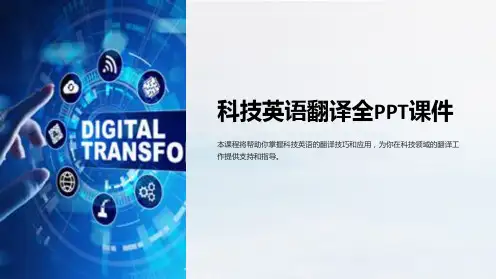
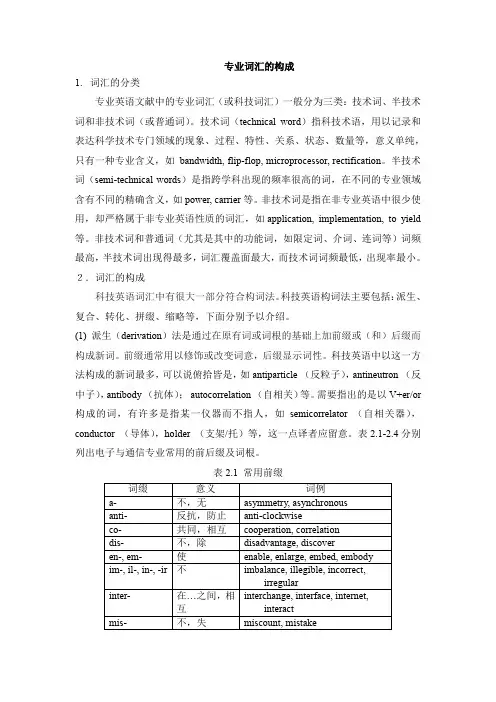
专业词汇的构成1.词汇的分类专业英语文献中的专业词汇(或科技词汇)一般分为三类:技术词、半技术词和非技术词(或普通词)。
技术词(technical word)指科技术语,用以记录和表达科学技术专门领域的现象、过程、特性、关系、状态、数量等,意义单纯,只有一种专业含义,如bandwidth, flip-flop, microprocessor, rectification。
半技术词(semi-technical words)是指跨学科出现的频率很高的词,在不同的专业领域含有不同的精确含义,如power, carrier等。
非技术词是指在非专业英语中很少使用,却严格属于非专业英语性质的词汇,如application, implementation, to yield 等。
非技术词和普通词(尤其是其中的功能词,如限定词、介词、连词等)词频最高,半技术词出现得最多,词汇覆盖面最大,而技术词词频最低,出现率最小。
2.词汇的构成科技英语词汇中有很大一部分符合构词法。
科技英语构词法主要包括:派生、复合、转化、拼缀、缩略等,下面分别予以介绍。
(1) 派生(derivation)法是通过在原有词或词根的基础上加前缀或(和)后缀而构成新词。
前缀通常用以修饰或改变词意,后缀显示词性。
科技英语中以这一方法构成的新词最多,可以说俯拾皆是,如antiparticle (反粒子),antineutron (反中子),antibody (抗体);autocorrelation (自相关)等。
需要指出的是以V+er/or 构成的词,有许多是指某一仪器而不指人,如semicorrelator (自相关器),conductor (导体),holder (支架/托)等,这一点译者应留意。
表2.1-2.4分别列出电子与通信专业常用的前后缀及词根。
表2.1 常用前缀表2.2 表示数量关系的常用前缀表2.3 常用后缀表 2.4 常用词根(2) 复合(composition)法是由两个或两个以上的词按照一定的次序排列,以构成新词,其词性可以是形容词、名词、代词、动词、副词等。
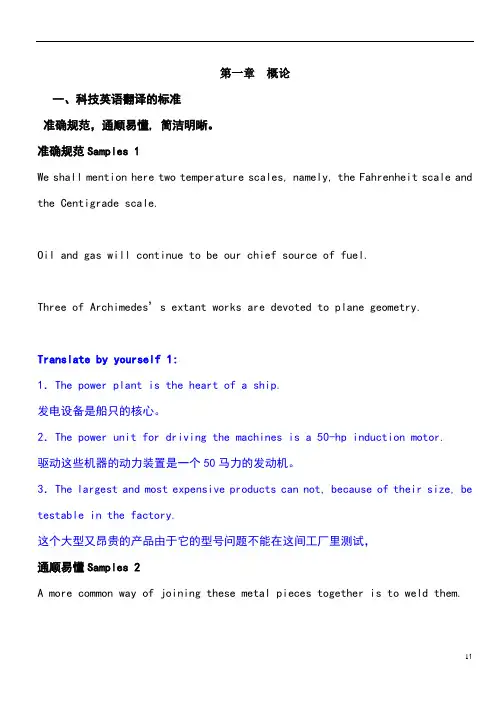
第一章概论一、科技英语翻译的标准准确规范,通顺易懂, 简洁明晰。
准确规范Samples 1We shall mention here two temperature scales, namely, the Fahrenheit scale and the Centigrade scale.Oil and gas will continue to be our chief source of fuel.Three of Archimedes’s extant works are devoted to plane geometry.Translate by yourself 1:1.The power plant is the heart of a ship.发电设备是船只的核心。
2.The power unit for driving the machines is a 50-hp induction motor.驱动这些机器的动力装置是一个50马力的发动机。
3.The largest and most expensive products can not, because of their size, be testable in the factory.这个大型又昂贵的产品由于它的型号问题不能在这间工厂里测试,通顺易懂Samples 2A more common way of joining these metal pieces together is to weld them.Molten salts range from ideally ionic fluids to molecular melts and liquid.These compressors have proved themselves useful in a variety of ways in installations where large volumes of air or other gases are compressed.Translate by yourself 2:1.Semiconductor devices, called transistors, are replacing tubes in many applications.被称为晶体管的半导体装置正在许多应用中取代电子管。
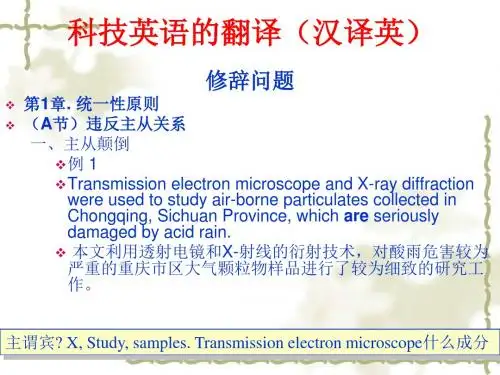

第一章概论1.科技英语翻译的概念翻译包括口译和笔译.在笔译中,又可分为科技翻译、文学翻译、政论文翻译和应用文翻译等等.翻译就是“把一种语言文字的意义用另一种语言文字表达出来".因而,翻译本身并不是一门独立的创造性科学,它既带有创造性,又带有科学性,它是用语言表达的一门艺术,是科学性的再创作。
随着国际学术交流的日益广泛,科技英语已经受到普遍的重视,掌握一些科技英语的翻译技巧是非常必要的。
科技英语(English for Science and Technology,简称EST)。
作为一种重要的英语文体,与非科技英语文体相比,具有词义多、长句多、被动句多、词性转换多、非谓语动词多、专业性强等特点,这些特点都是由科技文献的内容所决定的.因此,科技英语的翻译也有别于其他英语文体的翻译。
2. 科技英语翻译的标准及要求科技英语的语域特征有别于其它语篇体裁。
充分认识和把握好科技英语的语体特征,对于研究科技翻译的标准,从而真正实现翻译中的语际意义转换,达到功能对等具有重要意义.综合以上分析,科技英语翻译的标准及要求可定位于以下几方面。
(一)准确性科技英语由于语场,语旨而决定其翻译也有别于其它翻译形式。
对于一般翻译,译文必须忠实于原文内容。
科技英语翻译除要忠实反映原文内容外,还要确保其信息传递的准确性.科技译文一般不用或很少用"可能",”大概"等模棱两可的修饰语言.因此,准确性是科技英语翻译最重要的标准。
失去了"准确性”,科技翻译就失去了灵魂(许树椿:4MNE)。
要保证科技译文的准确性,译者必须精心研究原文,充分理解原文,然后用准确流畅的译入语表达。
(二)通顺完整性通顺既包括译文的表达,也包括译文的完整.表达是译者在理解原文的基础上,把所理解的东西用另一种语言阐述的过程.这一过程必须在确切理解原文的前提下进行,并且在尽量保持原文表达形式的同时,必须保证译文合乎译入语的规范,行文尽量通顺流畅,简单明了,让读者一看就懂。
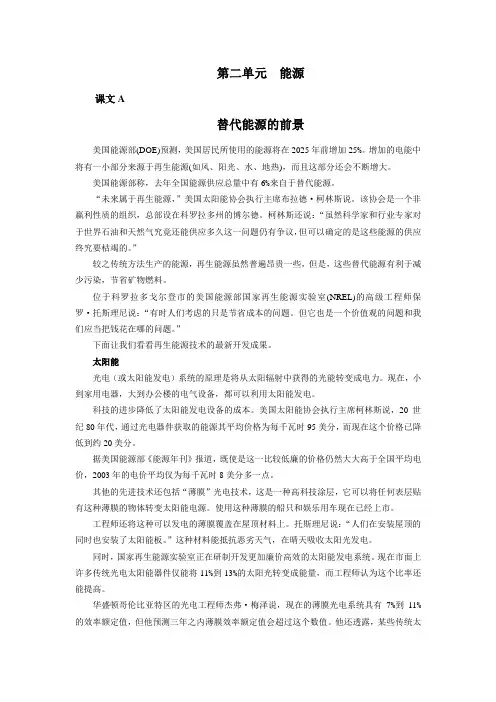
第二单元能源课文A替代能源的前景美国能源部(DOE)预测,美国居民所使用的能源将在2025年前增加25%。
增加的电能中将有一小部分来源于再生能源(如风、阳光、水、地热),而且这部分还会不断增大。
美国能源部称,去年全国能源供应总量中有6%来自于替代能源。
“未来属于再生能源,”美国太阳能协会执行主席布拉德·柯林斯说。
该协会是一个非赢利性质的组织,总部设在科罗拉多州的博尔德。
柯林斯还说:“虽然科学家和行业专家对于世界石油和天然气究竟还能供应多久这一问题仍有争议,但可以确定的是这些能源的供应终究要枯竭的。
”较之传统方法生产的能源,再生能源虽然普遍昂贵一些,但是,这些替代能源有利于减少污染,节省矿物燃料。
位于科罗拉多戈尔登市的美国能源部国家再生能源实验室(NREL)的高级工程师保罗·托斯理尼说:“有时人们考虑的只是节省成本的问题。
但它也是一个价值观的问题和我们应当把钱花在哪的问题。
”下面让我们看看再生能源技术的最新开发成果。
太阳能光电(或太阳能发电)系统的原理是将从太阳辐射中获得的光能转变成电力。
现在,小到家用电器,大到办公楼的电气设备,都可以利用太阳能发电。
科技的进步降低了太阳能发电设备的成本。
美国太阳能协会执行主席柯林斯说,20世纪80年代,通过光电器件获取的能源其平均价格为每千瓦时95美分,而现在这个价格已降低到约20美分。
据美国能源部《能源年刊》报道,既使是这一比较低廉的价格仍然大大高于全国平均电价,2003年的电价平均仅为每千瓦时8美分多一点。
其他的先进技术还包括“薄膜”光电技术,这是一种高科技涂层,它可以将任何表层贴有这种薄膜的物体转变太阳能电源。
使用这种薄膜的船只和娱乐用车现在已经上市。
工程师还将这种可以发电的薄膜覆盖在屋顶材料上。
托斯理尼说:“人们在安装屋顶的同时也安装了太阳能板。
”这种材料能抵抗恶劣天气,在晴天吸收太阳光发电。
同时,国家再生能源实验室正在研制开发更加廉价高效的太阳能发电系统。
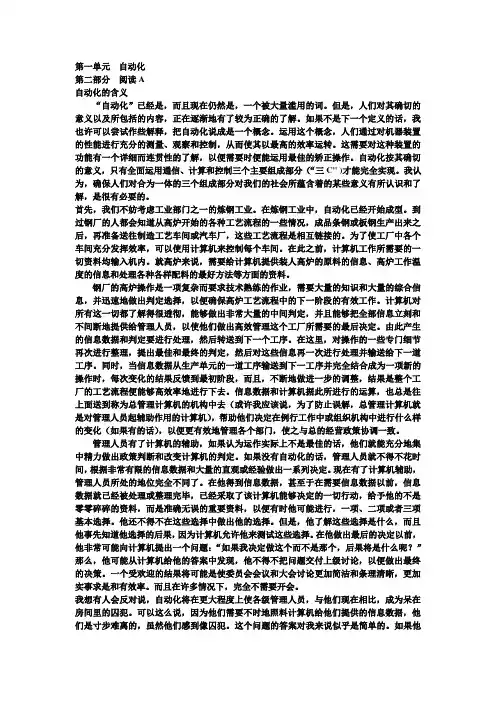
第一单元自动化第二部分阅读A自动化的含义“自动化”已经是,而且现在仍然是,一个被大量滥用的词。
但是,人们对其确切的意义以及所包括的内容,正在逐渐地有了较为正确的了解。
如果不是下一个定义的话,我也许可以尝试作些解释,把自动化说成是一个概念。
运用这个概念,人们通过对机器装置的性能进行充分的测量、观察和控制,从而使其以最高的效率运转。
这需要对这种装置的功能有一个详细而连贯性的了解,以便需要时便能运用最佳的矫正操作。
自动化按其确切的意义,只有全面运用通信、计算和控制三个主要组成部分(“三C" )才能完全实现。
我认为,确保人们对合为一体的三个组成部分对我们的社会所蕴含着的某些意义有所认识和了解,是很有必要的。
首先,我们不妨考虑工业部门之一的炼钢工业。
在炼钢工业中,自动化已经开始成型。
到过钢厂的人都会知道从高炉开始的各种工艺流程的一些情况,成品条钢或板钢生产出来之后,再准备送往制造工艺车间或汽车厂,这些工艺流程是相互链接的。
为了使工厂中各个车间充分发挥效率,可以使用计算机来控制每个车间。
在此之前,计算机工作所需要的一切资料均输入机内。
就高炉来说,需要给计算机提供装人高炉的原料的信息、高炉工作温度的信息和处理各种各样配料的最好方法等方面的资料。
钢厂的高炉操作是一项复杂而要求技术熟练的作业,需要大量的知识和大量的综合信息,并迅速地做出判定选择,以便确保高炉工艺流程中的下一阶段的有效工作。
计算机对所有这一切都了解得很透彻,能够做出非常大量的中间判定,并且能够把全部信息立刻和不间断地提供给管理人员,以使他们做出高效管理这个工厂所需要的最后决定。
由此产生的信息数据和判定要进行处理,然后转送到下一个工序。
在这里,对操作的一些专门细节再次进行整理,提出最佳和最终的判定,然后对这些信息再一次进行处理并输送给下一道工序。
同时,当信息数据从生产单元的一道工序输送到下一工序并完全结合成为一项新的操作时,每次变化的结果反馈到最初阶段,而且,不断地做进一步的调整,结果是整个工厂的工艺流程便能够高效率地进行下去。
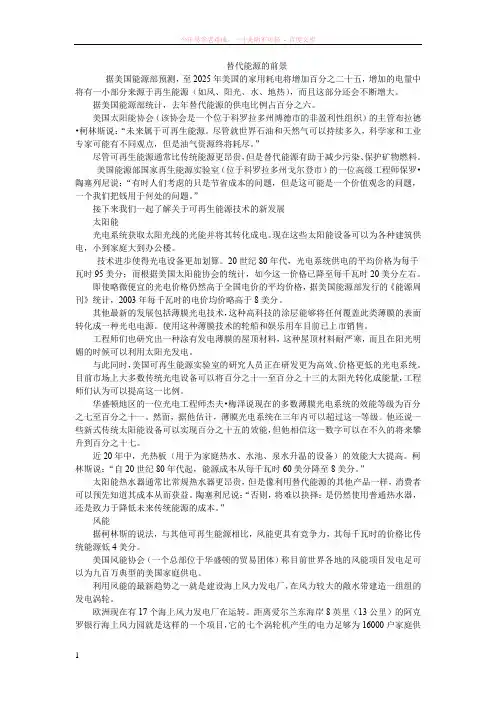
替代能源的前景据美国能源部预测,至2025年美国的家用耗电将增加百分之二十五,增加的电量中将有一小部分来源于再生能源(如风、阳光、水、地热),而且这部分还会不断增大。
据美国能源部统计,去年替代能源的供电比例占百分之六。
美国太阳能协会(该协会是一个位于科罗拉多州博德市的非盈利性组织)的主管布拉德•柯林斯说:“未来属于可再生能源。
尽管就世界石油和天然气可以持续多久,科学家和工业专家可能有不同观点,但是油气资源终将耗尽。
”尽管可再生能源通常比传统能源更昂贵,但是替代能源有助于减少污染、保护矿物燃料。
美国能源部国家再生能源实验室(位于科罗拉多州戈尔登市)的一位高级工程师保罗•陶塞列尼说:“有时人们考虑的只是节省成本的问题,但是这可能是一个价值观念的问题,一个我们把钱用于何处的问题。
”接下来我们一起了解关于可再生能源技术的新发展太阳能光电系统获取太阳光线的光能并将其转化成电。
现在这些太阳能设备可以为各种建筑供电,小到家庭大到办公楼。
技术进步使得光电设备更加划算。
20世纪80年代,光电系统供电的平均价格为每千瓦时95美分;而根据美国太阳能协会的统计,如今这一价格已降至每千瓦时20美分左右。
即使略微便宜的光电价格仍然高于全国电价的平均价格,据美国能源部发行的《能源周刊》统计,2003年每千瓦时的电价均价略高于8美分。
其他最新的发展包括薄膜光电技术,这种高科技的涂层能够将任何覆盖此类薄膜的表面转化成一种光电电源。
使用这种薄膜技术的轮船和娱乐用车目前已上市销售。
工程师们也研究出一种涂有发电薄膜的屋顶材料,这种屋顶材料耐严寒,而且在阳光明媚的时候可以利用太阳光发电。
与此同时,美国可再生能源实验室的研究人员正在研发更为高效、价格更低的光电系统。
目前市场上大多数传统光电设备可以将百分之十一至百分之十三的太阳光转化成能量,工程师们认为可以提高这一比例。
华盛顿地区的一位光电工程师杰夫•梅泽说现在的多数薄膜光电系统的效能等级为百分之七至百分之十一。
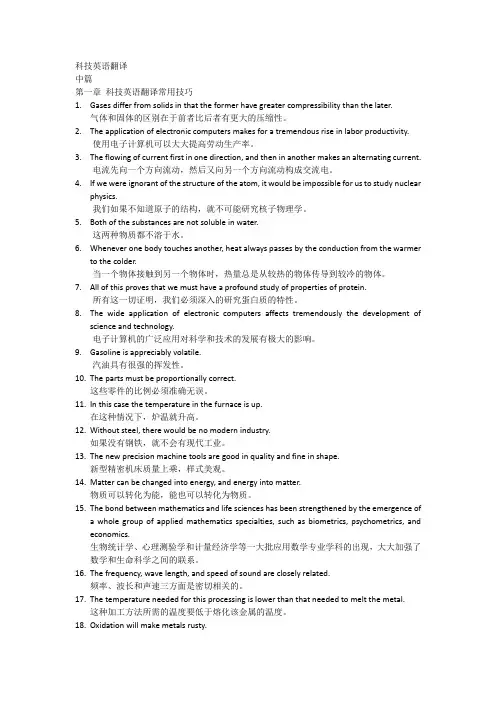
科技英语翻译中篇第一章科技英语翻译常用技巧1.Gases differ from solids in that the former have greater compressibility than the later.气体和固体的区别在于前者比后者有更大的压缩性。
2.The application of electronic computers makes for a tremendous rise in labor productivity.使用电子计算机可以大大提高劳动生产率。
3.The flowing of current first in one direction, and then in another makes an alternatingcurrent.电流先向一个方向流动,然后又向另一个方向流动构成交流电。
4.If we were ignorant of the structure of the atom, it would be impossible for us to studynuclear physics.我们如果不知道原子的结构,就不可能研究核子物理学。
5.Both of the substances are not soluble in water.这两种物质都不溶于水。
6.Whenever one body touches another, heat always passes by the conduction from thewarmer to the colder.当一个物体接触到另一个物体时,热量总是从较热的物体传导到较冷的物体。
7.All of this proves that we must have a profound study of properties of protein.所有这一切证明,我们必须深入的研究蛋白质的特性。
8.The wide application of electronic computers affects tremendously the development ofscience and technology.电子计算机的广泛应用对科学和技术的发展有极大的影响。
Unit 2 Physics1. Directions: Work on your own and fill in the blanks with the main idea.Part 1 (Paras. 1-3): Brief introduction to dark energy Para. 1: Dark energy is an unexplained force which tugs galaxies away from each other.Para. 2: Dark energy is somewhat like anti-gravity.Para. 3: Dark energy is scientists’ hypothetic form of energy to explain the universe’s expansion.Part 2 (Paras. 4-9): The discovery of dark energy: confounding expectationsPara. 4: The discovery of dark energy is a case of science confounding expectations.Para. 5: Experts expected that gravity had slowed down the universe’s rate of expansion.Para. 6: The universe’s rate of expansion was speeding up.Para. 7: The result was beyond experts’ expectations which caused much nervous laughter.Para. 8: The measurements of supernovae provided the evidence that the universe’s rate of ballooning was speeding up.Para. 9: The scientists observed many supernovae at different distances to determine how fast they are speeding away from us.Part 3 (Paras. 10-13): The rate of the expansion of the universe: shocking resultsPara. 10: The rate of the universe’s expansion is accelerating.Para. 11: More researches done by other experts also show the same results.Para. 12: Einstein’s cosmologica l constant has been revived to explain the puzzling findings.Para. 13: The cosmological constant is one of the leading theories to explain the expansion of theuniverse.Part 4 (Paras. 14-17): The difference between dark energy and dark matterPara. 14: The confusion of dark energy and dark matter.Para. 15: Dark matter is an invisible hypothesized form of matter.Para. 16: Dark matter and dark energy seem to make up most of the mass of the universe.Para. 17: The discovery of dark energy stirred up a lot of other issues, such as making some peoplebelieve that there are several universes.2. Directions: Complete the sentences with the words givenin the brackets. Change the form if necessary.1)Skin injury, infection, stress, and certain drugs maytrigger psoriasis. Skin cells move at an accelerated ratefrom the dermis into the epidermis, where they sloughoff, causing inflammation.牛皮癣可能由皮肤外伤、感染、压力和某些药物引起。